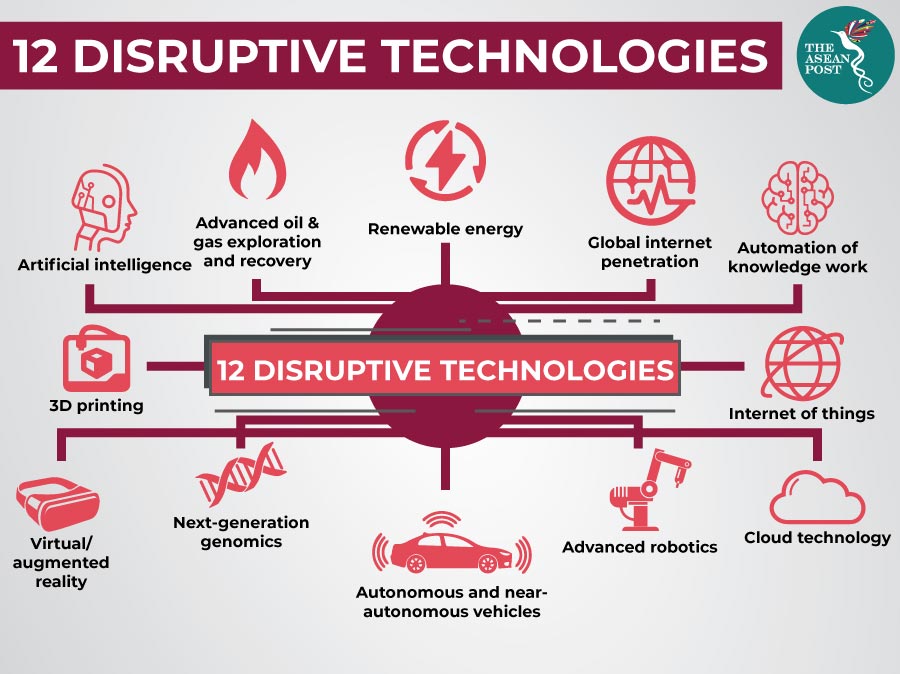The rapid growth of technology has brought about unprecedented disruption to multiple industries. Previously, technological advancements that would cause a shift across entire sectors would only come about once a decade. However, thanks to how quickly technology is evolving today, new disruptive technologies are coming to the fore every day. Some examples of disruptive technologies include – but are not limited to – cloud computing, the internet of things (IoT), autonomous vehicles and artificial intelligence (AI).
While Southeast Asia can be slower than its western counterparts in integrating such technologies, elements of disruptive technologies are already being felt. It may vary from country to country, but automation, virtual reality, AI and cloud computing are starting to become mainstream. The growing influence of disruptive technologies in Southeast Asia is largely due to the region’s high rate of internet penetration. The region is home to 630 million people and has an internet penetration rate of 53 percent. This is vital as the internet is central to the growth and influence of these new technologies.
The effects of disruptive technologies are already taking place in Southeast Asian society. Artificial intelligence is currently being utilised to improve efficiency in the healthcare systems of Thailand and Singapore. In Thailand, the Bumrungrad International Hospital has integrated the IBM Watson into their oncology department. The IBM Watson has a processing power capability of 80 teraflops and can access 90 servers with data storage equivalent to more than 200 million pages. The oncology department at Bumrungrad International Hospital uses the IBM Watson to process patient data, medical literature and guidelines to offer personalized treatments to its cancer patients.
Meanwhile, in Singapore, the Saw Swee Hock School of Public Health and the National Environmental Agency have developed an AI agent that can forecast dengue incidences up to four months ahead. If successful, this system could be deployed to other Southeast Asian hospitals to curb the spread of dengue fever in the region.

Aside from artificial intelligence, the introduction of automation in the Southeast Asian manufacturing sector could also have a considerable effect. At the moment, Southeast Asia is one of the biggest manufacturing hubs outside of China, in part because of its cheap labour. The introduction of automation in this industry could completely transform it as it would increase efficiency and further lower costs. The downside of it however, is that it could potentially take away jobs from many people in the region. The International Labour Organisation (ILO) said in a report titled “ASEAN in Transformation”, that half of the salaried workers – approximately 137 million workers – in Cambodia, Indonesia, Vietnam, the Philippines and Thailand might lose their jobs in the next 20 years.
Job losses on a large scale will transform the region, be it for better or worse. If the governments in ASEAN take the proper steps in handling such a situation, it could actually bring about a positive shift. For instance, if governments spend money on retraining and upskilling their workers, it would shift the region from a low-skilled economy to a high-income economy as workers are freed from becoming low-waged, unskilled labour in the manufacturing industry.
The startup scene in the region is another exciting area at the moment. The startup scene is where many of the innovations and experimentations with disruptive technologies are occurring. Startups with a focus on e-commerce are experimenting with blockchain while e-hailing firms are toying with the idea of autonomous vehicles.
Recognising the importance of disruptive technologies and their capabilities to improve human lives, the ASEAN chair in Singapore recently mooted the idea of an ASEAN Smart Cities Network where disruptive technologies are the main drivers of society. Envisioned as cities of the future, designated smart cities in the region will utilise technology and digital solutions to resolve problems and create new opportunities which would then help improve the lives of its citizens.
Southeast Asia is no longer the agricultural backwater it was a century ago. It has since evolved into a dynamic region that’s set to become one of the biggest economies in the world. By embracing disruptive technologies and consolidating them into initiatives such as the ASEAN Smart Cities Network, Southeast Asia could propel itself into the future faster than many expect it to.
